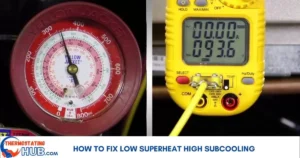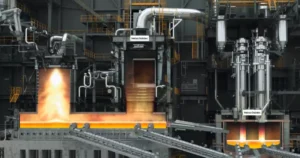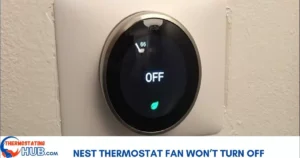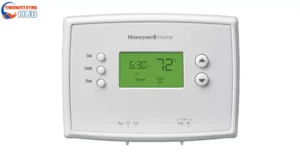Having trouble getting your Sensi thermostat to power up the AC? This guide is here to assist you. Several factors could be causing the thermostat not to activate your air conditioning unit, and we’ll explore them in this guide along with their solutions.
The most common reasons for your Sensi thermostat failing to switch on the AC include incorrect thermostat settings, power problems with the condenser unit, a malfunctioning AC contactor, a faulty capacitor, or issues with the compressor unit. Sometimes, a simple thermostat reset might also be the solution.
While many of these issues can be resolved without professional help, certain problems may require licensed HVAC professionals to intervene.
Refer to the table below for an overview of the primary causes behind a Sensi thermostat not activating the AC and potential fixes.
Pro Tip: Regularly checking and maintaining your HVAC system can prevent unexpected malfunctions. Schedule routine inspections to ensure smooth operation and catch issues early. 🛠️
8 Reasons for a Sensi thermostat not turning on A/C
| Possible Cause | Fix |
| Wrong thermostat settings | Set the thermostat to cool and temp point below current room temperature |
| Wrong thermostat wiring | Ensure wires for the compressor relays are connected |
| Power issues | Check breakers and reset them where necessary |
| The thermostat needs a reset | Reset your thermostat |
| Low thermostat battery | If your thermostat uses a battery, replace them |
| Defective AC contactor | Replace AC contactor |
| Defective AC capacitor | Replace AC capacitor |
| Defective compressor | Replace compressor |
Now, let’s delve into the specifics of troubleshooting these issues.
💡 Pro Tip: Regular maintenance and timely replacement of worn-out parts can prevent major AC malfunctions. Schedule professional inspections annually to ensure your system operates efficiently and avoids sudden breakdowns.
Wrong thermostat settings

Is your thermostat set correctly? Confirm the thermostat settings and make sure it’s set to cooling mode.
Adjust the thermostat temperature to be lower than the current room temperature. If the set temperature exceeds the room temperature, your condenser unit won’t activate.
If everything seems in order, check if the outdoor condenser unit is connected to power.
Pro tip: Regularly maintaining your HVAC system, including checking the thermostat settings and outdoor unit, helps ensure efficient cooling and prevents potential issues.
Power issues
Once you’ve given your thermostat a thorough check and everything appears fine, ensuring that the AC compressor unit has access to power is a good idea.
Power problems may occur due to tripped circuit breakers. If your Sensi thermostat isn’t activating the condenser unit, head over to your electrical panel and inspect the switches to see if any have tripped. The switch responsible for the AC unit might be labeled differently in the breaker box, but it’s typically marked as A/C.
Should you find this switch tripped, reset it. If it remains unaffected and the condenser unit doesn’t kick in when you adjust the thermostat, there might be another power-related issue. This could potentially be due to a faulty AC contactor, located within the condenser unit itself.
At this point, verifying the wiring connected to your thermostat is advisable. If the wiring checks out, it’s recommended to check the AC contactor and capacitor for any faults.
Pro Tip: Regularly checking and maintaining your AC unit’s power supply and components can help prevent potential issues, ensuring efficient cooling during hot days.
Wrong thermostat wiring
The Sensi might not turn on your AC if incorrect thermostat wiring. When installing a new thermostat, double-check the wires to avoid common mistakes.
Refer to your manual for specific instructions for cooling with a Sensi thermostat. Generally, ensure these wires are connected to their respective terminals:
- RC terminal: Powers the cooling system
- Y wire: Controls the 1st stage of the air conditioner or heat pump
- Y2 wire: Manages the 2nd stage of the air conditioner or heat pump
If your system doesn’t use batteries, check for a connected C-wire, usually blue. This wire supplies consistent power for the thermostat to function correctly.
Pro tip: Before installation, take a photo of the original wiring to ensure correct connections and troubleshoot easily if needed.
Read also: Should You Go For Nest Dual Fuel or Single Fuel?
The thermostat needs a reset
If your Sensi’s wiring seems fine but your AC isn’t turning on, a quick fix might involve restarting or resetting your thermostat. However, proceed with caution as a reset can erase your thermostat’s programming. Begin by restarting it, as this action won’t delete the schedules and programs, unlike a reset. If neither of these methods resolves the issue and your thermostat operates on batteries, it could simply have low battery power.
Pro Tip: Regularly checking and replacing thermostat batteries can prevent sudden AC issues, ensuring smooth functioning and avoiding unnecessary resets.
Low thermostat battery
When batteries run low, they can lead to various issues with your cooling or heating systems. Batteries typically last up to 12 months, but it’s essential to check with the specific manufacturer for their lifespan.
Low or dying batteries might result in a dim display on your thermostat. Your system could struggle to respond to adjustments on the thermostat, and in certain instances, it might not respond at all.
In essence, if you suspect your thermostat batteries are running low, replacing them could resolve the entire issue. It’s a simple fix that can make a significant difference. 🔋
Pro Tip: Regularly check and replace thermostat batteries to maintain an efficiently functioning HVAC system.
Defective AC contactor
A faulty contactor might be the cause if your Sensi or any other thermostat model isn’t activating your AC. The contactor serves to energize your AC system when there’s a demand for cooling.
The AC contactor may deteriorate as time passes, causing it to become stuck in the open position. When this occurs, it fails to power the condenser unit despite the cooling signal from your thermostat.
Replacing the contactor is a simple and cost-effective solution to resolve this issue. It can swiftly rectify the problem and get your AC system back up and running smoothly. 😊
Pro Tip: Regularly checking and maintaining your AC’s components, like the contactor, can prevent unexpected breakdowns and ensure efficient operation throughout the year.
Defective AC capacitor

If the contractor isn’t faulty, you might want to check the condenser capacitor. This device stores energy for starting the compressor. A faulty compressor could hinder your AC from turning on, irrespective of the thermostat model used.
Spotting a defective capacitor is straightforward.
Simply check for a bulged top – a clear sign that your capacitor needs replacing.
Sometimes, the signs aren’t visible, requiring a multimeter to test for continuity.
Much like a contactor, replacing an AC capacitor is easy and inexpensive. You can order one online. However, take necessary precautions as capacitors can store high voltage, requiring careful handling.⚡
Pro Tip: Before attempting any repairs, always ensure to turn off the power to your AC unit to avoid accidents or electric shocks.
Defective compressor
A faulty compressor can completely halt the functioning of your AC. It’s the heart of the AC system. When a compressor fails, the only fix is purchasing a new one. If the compressor’s cost exceeds 50% of the total expense for a new system, it’s usually advised to opt for a complete system replacement.
While compressor failure isn’t common, like any machine, it’s prone to wear and tear.
Pro Tip: Regular maintenance can significantly extend the lifespan of your AC system. Schedule routine check-ups to prevent unexpected breakdowns.
AC Activation Solutions
When troubleshooting your Sensi Thermostat for AC activation issues, start by checking the thermostat settings. Ensure that it’s set to ‘Cool’ mode and the temperature is set lower than the current room temperature. Sometimes, a simple adjustment can solve the problem.
Next, confirm that the thermostat has power. Check if it’s properly connected to your home’s electrical system and the display functions. If the display is blank or unresponsive, it might indicate a power issue.
Inspect the air filter; a clogged filter can restrict airflow and hinder the cooling system’s performance. Replace the filter if it’s dirty or blocked.
Also, examine the circuit breaker or fuse box connected to your HVAC system. A tripped breaker or blown fuse could disrupt power to the air conditioning unit.
Lastly, if none of these steps resolve the issue, consider checking the Sensi Thermostat’s compatibility with your HVAC system. Ensure it’s compatible and installed correctly, following the manufacturer’s instructions. If problems persist, contacting Sensi customer support or a professional HVAC technician might be necessary for further diagnosis and assistance.
Preventing Sensi Thermostat AC Issues

Preventing Sensi thermostat AC issues is crucial for maintaining a comfortable indoor environment. Start by regularly cleaning or replacing your HVAC system’s air filters. Clogged filters can strain your AC unit, leading to potential malfunctions. Check and clean the thermostat itself to ensure dust or debris isn’t affecting its functionality.
Proper installation and regular maintenance are key. Ensure correct installation of the Sensi thermostat and follow manufacturer guidelines for upkeep. Conduct routine checks on the thermostat’s batteries to prevent sudden power failures. Additionally, keep the area around the thermostat clear of objects that might obstruct its sensors, affecting temperature readings.
Stay updated with firmware or software updates provided by Sensi to ensure your thermostat operates smoothly. Lastly, if you encounter persistent issues, consult the manufacturer’s troubleshooting guide or seek professional HVAC assistance promptly to address any potential concerns before they escalate.
FAQs
Why is my AC not turning on with Sensi?
There could be several reasons why your AC isn’t turning on with the Sensi thermostat. Check if the thermostat is set to the correct mode (cooling), ensure the temperature setting is lower than the room temperature, and verify the Sensi device is connected to Wi-Fi and properly configured.
Why is my thermostat not activating the AC?
The thermostat might not be activating the AC due to issues with power supply, incorrect settings, a malfunction in the thermostat itself, or a problem with the AC unit. Verify the power source, check the settings, and ensure the thermostat is functioning correctly.
Why is my thermostat not getting power to my AC unit?
If the thermostat isn’t receiving power, it could be due to a blown fuse, a tripped circuit breaker, a disconnected or faulty wiring connection, or issues with the power source. Check these elements to troubleshoot the power supply to the thermostat and AC unit.
Why won’t my thermostat work with the AC?
Several factors can prevent a thermostat from working with the AC, including compatibility issues between the thermostat and the AC unit, incorrect wiring, a malfunctioning thermostat, or issues with the cooling system. Verify compatibility, check the wiring connections, and ensure the thermostat is configured properly for AC control.
Final Thoughts
To conclude, the issues outlined in this guide are frequently the primary reasons why a Sensi thermostat fails to activate an air conditioner. We trust you’ve managed to resolve the problem by this point. If not, we strongly advise seeking assistance from nearby professionals.

I’m James Wilson, your HVAC maestro from “Thermostating Hub.” Elevate your comfort with my expertise in heating, ventilation, and air conditioning. Let’s transform your space into a haven of perfect temperatures, tackling HVAC issues with precision and enthusiasm.
![Sensi Thermostat Not Turning On AC [Fixed]](https://thermostatinghub.com/wp-content/uploads/2023/12/sensi-thermostat-not-turning-on-ac.webp)













